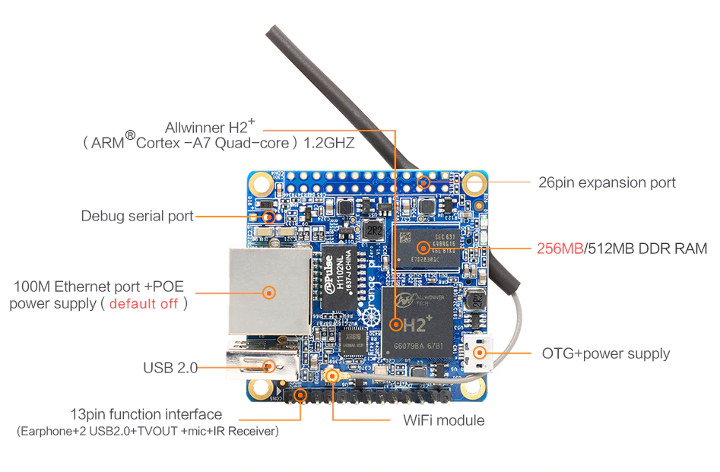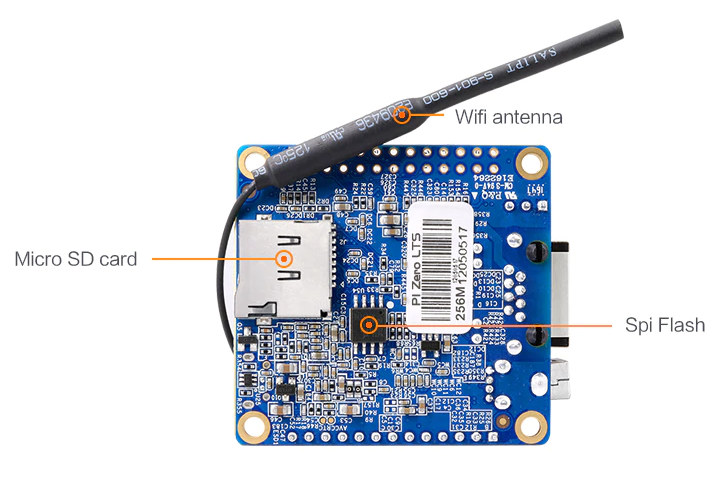Orange Pi Zero LTS is an update to Orange Pi Zero Allwinner H2+ board with the same specifications, but tweaks to the hardware that Shenzhen Xunlong Software claims lower power consumption and reduce heat.
The SBC supports Armbian’s Debian and Ubuntu images, and best suited for headless applications that require network connectivity via Ethernet and/or WiFi such as smart speakers. The board also features one USB port, and two I/O headers for expansion. The good news is that you can now buy Orange Pi Zero LTS for the same price as the original model, namely $8.49 for the 256MB RAM version, and $10.49 for the 512MB model$10.49 for the 512MB model, excluding shipping costs ($4.73 to my location).

Here’s a reminder of Orange Pi Zero LTS (v1.5) specifications:
- SoC – Allwinner H2+ quad-core Cortex A7 processor @ 1.2 GHz with Mali-400MP2 GPU @ 600 MHz
- System Memory – 256 to 512 MB DDR3-1866 SDRAM
- Storage – MicroSD card slot, SPI flash (likely 2MB)
- Connectivity
- 10/100M Ethernet
- 802.11 b/g/n WiFi via Allwinner XR819 module with u.FL antenna connector and external antenna
- USB – 1x USB 2.0 host port, 1x micro USB OTG port
- Expansion headers
- Unpopulated 26-pin GPIO header mostly compatible with Raspberry Pi (1) header
- 13-pin header with headphone, 2x USB 2.0, TV-out, microphone and IR receiver signals
- Debugging – 3-pin header for serial console
- Misc – 2x LEDs
- Power Supply – 5V via micro USB port or optional PoE
- Dimensions – 48 x 46 mm
- Weight – 26 grams
 Some important information for those just getting started.
Some important information for those just getting started.
- Allwinner XR819 WiFi module does work, but performance is usually inferior to Ampak modules. It’s still good enough for most purpose however.
- The company provides Ubuntu, Debian, Raspbian, Android 4.2/7.0, and OpenWrt images on their resources page (look for “Orange Pi Zero”), but if you want to avoid headaches, go for one of the Linux images on Armbian website instead.
- There’s no video output, except for the TV out on the header for composite video.
- The SPI flash can be used to store U-boot, so network boot is feasible without the need for a microSD card.
While we do have numbers showing lower power consumption and temperature, the company did not provide details explaining how they managed to improve the board’s efficiency. They may have done improvements to the power circuitry, but some people suspect they may have just lowered the CPU supply voltage, hence limiting the maximum CPU frequency and as a result lowering performance. This will have to be tested independently.

Jean-Luc started CNX Software in 2010 as a part-time endeavor, before quitting his job as a software engineering manager, and starting to write daily news, and reviews full time later in 2011.
Support CNX Software! Donate via cryptocurrencies, become a Patron on Patreon, or purchase goods on Amazon or Aliexpress. We also use affiliate links in articles to earn commissions if you make a purchase after clicking on those links.





The Problem? It uses a garbage XRadio WiFi chip.
The xradio chip is probably fine as it’s originally an st-ericsson design. Unlike almost everything except broadcom chips virtual interfaces etc actually work.
If someone could work out why it drops so many frames it would be very good for such a cheap chip.
between this and the Nanopi Duo2, which would you recommend going for? And I guess which would have the better support and ecosystem?
A bit of shot in the dark… but anyone know if it possible to do gpio with either through Java? At least for first-pass prototyping I mostly make stuff up in Clojure lately 😛
You can use sysfs to handle the gpios. Every gpio is a file, so you just need to open, read and write in those files using java or whatever programming language.
https://elinux.org/GPIO
Writing a library for the not deprecated character interface would be a better idea.. or using an interface generator to put a wrapper around the existing C library for the aforementioned character interface.
Oh interesting! That’s really good to know. So it can be written in a pretty generic way then. Thanks for that, and I can test that out over the weekend with another board pretty easily 🙂
Does the same go for things like i2c and spi?
Both i2c and spi have character interfaces that can be driven like files but really need ioctl() calls to be useful. There are probably libraries out there that wrap it all for you.
This helped a lot and pointed me in the right direction 🙂
There is actually the Java DIO library (part of the JDK) That should handle this. I’ll give it a shot and post an update if it works
Is there anything to keep in mind between this and the Nanopi Duo2? I like the breadboard friendly form factor but this one seems to have more buzz about it
Did you notice https://github.com/sgjava/userspaceio ? I’m not a Java person, and have no opinion on the Java bindings there, but I have used the python bindings before.
I’m not sure, but I seem to recall that the author was pretty active in discussion on the libgpiod (the canonical C userspace implementation) github issues, but they seem to have been deleted when the project moved to kernel.org. If I’m remembering right it highlights that the userspaceio project is pretty on top of staying up to date and compliant with the modern kernel interface.
thanks for that! it looks like the most up to date Java binding. I’m going to see if it’s easiest to use this or to do it manually through JNA.
I2S pins are accessible on LTS and zero2 to avoid to make something crazy like on this topic ?
Not allow to make good boombox with opi zero is a shame.
https://forum.armbian.com/topic/6021-orange-pi-zero-i2s/
ROCK Pi S in Debian headless idle current is 9mA@5V.
I somehow forgot about the board: https://www.cnx-software.com/2019/06/19/rock-pi-s-tiny-sbc-rockchip-rk3308-processor/
Cortex-A35 cores should indeed help getting low power consumption. 45mW seems really low though. Is it idle, or suspend to ram?
Sorry, my previous comment is wrong. Just confirmed, for Debian suspend to ram is 9mA. For Debian headless, idle is below 50mA.
>suspend to ram is 9mA.
What are the wake up options? Does waking from an RTC alarm or WiFi interrupt work?
Where does one purchase the elusive ROCK Pi S? Seeed Studio appears to carry the ROCK Pi 4, but no mention of the S.
$ 9 shipping, no thanks
Hi Jean, do you know if the circuit diagram for the 13-pin expansion board is available? My expansion board is v1.2
I’ve attached the Orange Pi Zero pinout diagram.
Source: https://medium.com/@chiehming.chang/orange-pi-zero-pinout-diagram-3b94068028c0
Thank you very much, but I was wondering about the 13 pin expansion board’s circuit diagram, the one shown here: https://auseparts.com.au/image/cache/catalog/OrangePi/ExBoard/OPEx%20board1-700×700.jpg
Only my expansion board is v1.2
Oh sorry, I read that wrong, I thought you asked for the pinout diagram of the expansion board. I don’t know if they released the schematics for the board.
Hi Jean, do you have any suggestions for an LCD display for orange pi zero LTS board, that works out of the box with the latest armbian image? I am using I have a waveshare 2.8 inch RPi LCD (https://www.waveshare.com/wiki/2.8inch_RPi_LCD_(A)); works perfectly on a Rapsberry pi, but is very troublesome on the orange pi zero. It looks like the culprit is some changes in the linux versions used in the newer images (eg, fbtft_device module does not exist). Some old forum discussions make it look like it is technically feasible to use this LCD with the orange pi zero, but the process looks complicated and I’m not familiar enough with Linux details to do this fast enough.
Could you suggest me some LCD’s that will just work if I connect it to the orange pi zero board please? Something available in amazon or ali-express will me much helpful. Armbian image I am using is Armbian_21.08.1_Orangepizero_focal_current_5.10.60.img (uname -a gives: Linux orangepizero 5.10.60-sunxi #21.08.1 SMP Wed Aug 25 18:19:32 UTC 2021 armv7l armv7l armv7l GNU/Linux
)
Could you also please let me know where I can find older OS images for the orange pi zero LTS? Looking at some forum discussions the first OS image released in 2017 might work more easily with the LCD, but I don’t know where to find the old versions
I can see the LCD uses SPI so it should be compatible, as long as SPI, PWM, and interrupt are enabled. Some tweaks might also be needed.
I’ve never used an SPI display with Orange Pi boards. I’d recommend browsing Armbian and/or Orange Pi forums to find one that works and potential solutions.